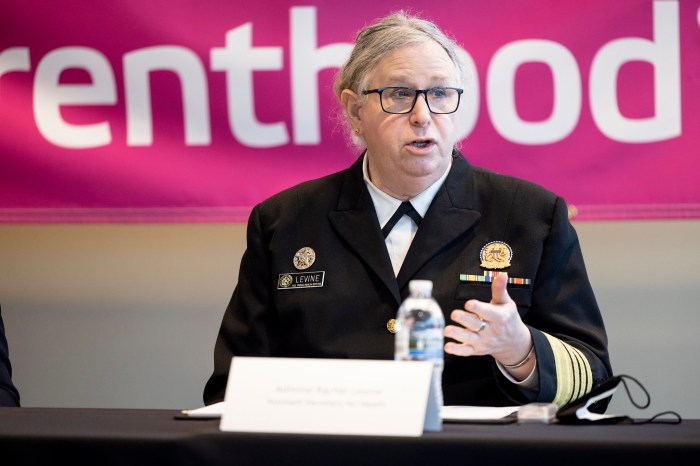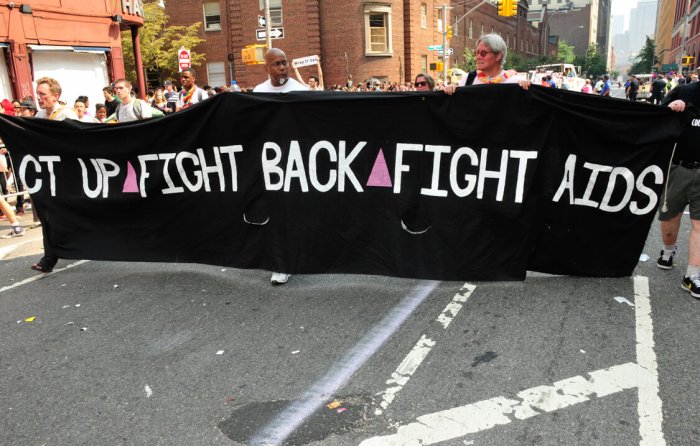A World AIDS Day rally in Times Square set out an ambitious goal of ending the HIV epidemic in New York within seven years. | DONNA ACETO
BY ANDY HUMM | Tis the season — to talk about AIDS. Largely gone from public consciousness in the United States — even in New York, its epicenter in this country — AIDS gets a “Day” every December 1 and most of the groups getting public and private funds to address it feel obligated to do so publicly.
Most public displays around town right now are designed to get us revved up to spend money for Christmas, and the red ribbon symbol of concern for AIDS often blends right in, to the point that many don’t know its meaning. At the next great gay holiday, the Oscars on March 2, presided over by out lesbian Ellen DeGeneres, it is doubtful that AIDS ribbons will be festooning any tuxedos or gowns. Last year, the biggest mention of AIDS there was the nomination for best documentary of David France’s “How to Survive a Plague” — a look at ACT UP at its peak 20 years ago.
World AIDS Day, of course, is not something to celebrate but to mark, as it has been for 25 years going back to the dark days before drug cocktails began to save lives. It is part solemn remembrance of the dead, part recommitment to fight it.
Advocates say goal achievable even without cure, vaccine
Housing Works executive director Charles King addressing the World AIDS Day gathering in Times Square. | DONNA ACETO
Which is not to say that there isn’t anything to celebrate. Treatment advances have brought mortality down dramatically since the mid-1990s. San Francisco activist Michael Petrelis, who is living with AIDS, has frequently asserted that health departments and AIDS non-profit organizations bury good news for fear of seeing funding drop. In a recent email, he pointed to the city’s 2012 HIV surveillance report that showed annual new HIV diagnoses in New York declining by about 40 percent since 2001. That same city report indicated that the incidence rate — the number of actual new infections as opposed to those diagnosed in any given year — declined by 42 percent between 2008 and 2012. The 2012 figures, however, were “preliminary.” The rate of decline from 2008 to 2011 was a far more modest 18 percent. Significantly, even using the 2012 preliminary findings, the decline in HIV incidence among men who have sex with men 30 and under was “not statistically significant.”
That point was driven home in a front page story in the New York Times on December 5 titled “Poor Black and Hispanic Men Are the Face of HIV” — though the article unfortunately conflated gay men and transgender women. That story reported the sobering statistic that among gay and bisexual men under 25 who become infected through sexual transmission, 80 percent are black or Latino.
The crowd at the December 1 AIDS Day rally in Times Square. | DONNA ACETO
Still, at a rally in Times Square on World AIDS Day, Charles King — himself HIV-positive and the leader of Housing Works, which serves many clients from communities of color — did talk about a celebration.
“Seven years from today,” he said, “we [will] gather again in a great day of celebration… to say that we were there at the beginning of the end, to say to our loved ones who passed on that we kept the faith, we kept up the fight, and AIDS did not win.”
King and others sounded the theme that AIDS can “end” by 2020 through a combination strategies: getting everyone tested and those positive into treatment, which would bring down their viral load to an undetectable level and make it virtually impossible for them to transmit the virus; convincing people at high risk for HIV to take a daily pre-exposure prophylaxis, or PrEP, pill to prevent them from getting infected; reminding those not on PrEP to take post-exposure prophylaxis, or PEP, drugs within 72 hours of a possible exposure; and continuing to promote condom use.
Studies show that young men of color actually use condoms more than white gay and bisexual men, but the men of color are drawing their sexual partners from a pool of mostly older men of color who either do not know their status or do not take anti-retroviral drugs sufficiently to prevent them from being infectious. They also face social conditions — more poverty, rejection of their sexual orientation in their homes, and worse healthcare that fails to treat sexually transmitted diseases that are HIV gateways — that set them up for their infections.
Public Advocate-elect Letitia James, currently a Brooklyn city councilmember, address the Times Square rally. | DONNA ACETO
The Times Square rally brought about 300 people together from a spectrum of AIDS organizations from GMHC to ACT UP. Both groups were co-founded by veteran activist Larry Kramer, who has been ailing and whose unique angry voice was missing. The HouseWorksVideos page on YouTube.
Many of the same people organized and attended another rally the following afternoon at the First Corinthian Baptist Church in Harlem, which — along with Chelsea and central Brooklyn — is a neighborhood particularly hard hit by HIV.
“You can’t take God seriously and not dignify all human beings,” the church’s pastor, Reverend Michael Walrond, Jr., told the crowd of several hundred. “Our communities are perishing because our people have not been educated.”
Walrond, who plans a run for the US House seat now held by longtime Democratic lawmaker Charlie Rangel, is a supporter of same-sex marriage, though he does not bless them in his church even while welcoming LGBT congregants.
Sean Barry, the executive director of VOCAL-NY, which works to empower people living with HIV, among other vulnerable communities, told Gay City News it is not enough to address the crisis among youth of color with condoms and drugs, but that they need “stable food and housing,” as well. His group is focused on again passing legislation that would cap rent for people living with AIDS receiving public assistance at 30 percent of their income. The Legislature approved the measure in 2010, but Mayor Michael Bloomberg prevailed on Governor David Paterson to veto it, and the measure died in the State Senate when in next came up last year.
Sean Barry of VOCAL-NY at the AIDS Day event in Harlem on December 2. | GAY CITY NEWS
Barry is hopeful that with the support of Mayor-elect Bill de Blasio, the bill will finally be enacted, though Governor Andrew Cuomo has been silent on it. Barry would like to see the governor say, in his January State of the State message, that “New York does big things and New York is going to be the first state to end AIDS by 2020.” If Cuomo doesn’t come through on the rent cap measure, VOCAL is prepared to camp outside his office in Albany until he does. The bill is being carried by out gay Senator Brad Hoylman, a West Side Democrat. Speaking at the Harlem rally, Hoylman told Gay City that he has gotten indications from Cuomo’s health department that the administration is sympathetic to the legislation.
Reginald Brown, also from VOCAL and one of the many speakers living with AIDS, told the rally, “Housing is health.” He said his rent takes 70 percent of his Social Security Disability check, leaving him $12-13 a day for food and everything else. He said he eventually got evicted and the city “paid more for me to stay in a shelter.” Wanda Hernandez, also with VOCAL, said she was diagnosed with AIDS in 1995 and worked two jobs to make ends meet until 2001. At that point, she was forced to go on disability and saw 75 percent of her checks go to rent.
Housing Works’ King spoke at this rally, too, reiterating that “today is a great day to end AIDS” and that it can be done “without a cure or vaccine.” “It is not about a lack of resources,” he said. “It is about a lack of political will.”
State Senator Brad Hoylman in Times Square. | DONNA ACETO
Estella Vazquez, the executive vice president of SEIU 1999, the healthcare workers union, said people of color are “at high risk, not because we engage in more risky behavior, but because of the lack of housing and health care and our disproportionate incarceration.” To end the epidemic, she said, “we must also eliminate homophobia, racism, and sexism.”
That’s a tall order and one that needs to be addressed every day of the year, not just for a week in December. Right now, the city doesn’t even have a subway and bus poster campaign that might put the plan to end AIDS in the public consciousness, especially the minds of vulnerable LGBT youth of color and those who love them.







































